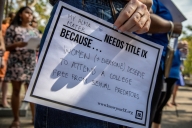You have /5 articles left.
Sign up for a free account or log in.

iStock.com/leightrail
Kevin Carey last week published a broad proposal for restructuring higher education as part of the annual Washington Monthly college guide.
As vice president for education policy and knowledge management at New America, a left-leaning Washington, D.C.-based think tank, Carey is an influential thinker on higher education policy. He writes regularly for "The Upshot" at The New York Times, and his ideas about topics as broad as college admissions or online program management (OPM) companies tend to nudge reform-minded congressional Democrats, among others.
Carey’s latest essay describes a “New Deal for America’s sinking colleges.” It features a proposal for a uniform pricing system for any college or university that opts in to a new annual federal subsidy of $10,000 per full-time-equivalent student. He also proposes that participating colleges be required to join a network for the seamless transfer of college credits.
Inside Higher Ed sent questions to Carey about the context for his proposal and how it might work. Those questions and his lightly edited responses are below.
Q: Higher education tends to change slowly, as you know. Do you think the pandemic makes the sort of system reboot you propose here more likely than the gradual iteration we've seen since the GI Bill's creation after WWII?
A: Higher education changes slowly and steadily over time. Federal policy tends to change not at all, and then all at once, particularly if you view it from the perspective of path dependency. Establishing a market-driven, voucher- and loan-based system in the 1960s and '70s didn’t create the current state of affairs overnight, but it dramatically narrowed the range of possible futures.
And there’s certainly never been more political will for drastic change in my lifetime. “Free college” went from Bernie Sanders’s crazy idea to table stakes for the Democratic presidential nomination in five years flat. Mass student loan forgiveness was nowhere on the mainstream agenda until, what, 2018? Now it’s a standard progressive policy plank. College unaffordability and student debt injustice have become fully integrated into the foundational mind-set of the largest generation in American history, all now of voting age and a growing number in public office. That has consequences
If Joe Biden wins the election and has the opportunity to pass major legislation through Congress next year, I don’t think the question will be “How can we dramatically overhaul the way the federal government finances higher education?” I think it will be “How can we not?”
Q: How would your proposed uniform pricing system work?
A: The goal is “Free for many, affordable for all,” which is the way things were for the baby boomers before they decided to deny the same benefits to their children. I propose free undergraduate tuition for anyone from households earning below $75,000 and then a gradual sliding scale up to $10,000 tuition for households earning above $250,000. None of the parameters are written in stone. As I say in the essay, I don’t think limiting the system to public universities and making tuition free for everyone is a good idea. There’s also a short version of the argument here.
In addition to making college universally affordable, the plan would make college pricing far more understandable. Unlike today, when the true price of college isn’t revealed until the end of the process, when you’re left with a sheaf of uncomparable, often-deceptive financial aid award letters, many parents and students would be choosing among colleges where tuition would be exactly the same.
Q: One requirement for colleges to participate would be to meet baseline measures of quality and success. Which metrics would be most important, and why do you think the federal government could create a fair, effective accountability system?
A: “Accountability” is a word that means different things to different people, so it helps to be clear on terms. There’s a kind of accountability focused on promoting excellence, like rewarding scholars for publishing in “top” journals. I know there are a million problems with that system, but I think we can agree that’s what it’s for.
IMHO it is far beyond the capacity of the government to design an accountability system that promotes excellence in higher education. Can’t be done, shouldn’t be tried. Excellence should be promoted through R&D, which the federal government is very experienced at funding, albeit hardly ever in pursuit of improved collegiate learning.
What the government can do effectively is enforce a different kind of accountability: consumer protection. Instead of using regulation to promote excellence, use it to ensure competence. Not “We want you to be better,” but “It’s illegal for you to be any worse than this.” With some common-sense statistical adjustments for mission and student body, I think we can say that colleges should be reasonably successful in helping students learn, graduate, get jobs and pay back their loans -- particularly since the colleges that enroll the largest number of at-risk students would, relative to their current budgets, get the biggest new subsidies under the plan. So you’re only held accountable if you get the resources you need to succeed.
Q: The credit-reciprocity network would go a long way toward saving students money and time. But given that it would include exemptions for core curricula and majors, how can you be confident colleges wouldn't continue to sometimes use academic requirements as an excuse for money-driven protectionism with credit transfer?
A: Some could, and probably will, continue to do that. But defining what it means to be well educated is -- or at least should be -- the central purpose of a college. Even if, with all the focus on marketing and athletics, it often doesn’t seem that way.
One of the best things about American higher education is that we give different institutions a lot of discretion to make different choices about standards, pedagogy and philosophy. I don’t want to change that. And I think faculty would justifiably reject any scheme that took away their right to define what learning means inside their academic disciplines. That’s mostly what the institution name on the diploma ought to signify.
That said, I think there should be some minimum obligations to transparency. If you’re going to reject outside credits because they’re inconsistent with your core curricular standards, you should be able to tell people ahead of time what that means.
Q: Wouldn't it be possible -- or even likely -- that the small group of universities that currently dominate the national market for online education would grab even more market share in this credit-reciprocity network? If so, would that be problematic?
A: They might get more market share. But that’s not necessarily a bad thing. There are economies of scale for certain kinds of online education. And that ultimately frees up resources to make college better, more accessible and more affordable.
Of course, we live in an era where every major industry seems to have consolidated into a duopoly, with a lot of emerging scholarship about how that has contributed to rising inequality and slowing economic growth.
But higher education is currently a long, long way from there. As of 2018, there were only 15 public or private nonprofit institutions that enrolled more than 10,000 fully online undergraduate students. Ten thousand is six one-hundredths of 1 percent of all undergraduates. We’re far from any kind of serious market consolidation.
Q: Your argument for nixing tax deductions for gifts to wealthy universities seems hard to oppose, even without the sweeping changes you propose. Why hasn't it happened?
A: There’s a very strong tradition in American law and culture of supporting nonprofit organizations. They’re a much bigger part of our civil society than elsewhere. The federal income tax deduction for charitable giving has been with us for more than a century -- almost as long as the income tax itself. So some of it is just habit, the way things have always been.
But the charitable deduction took a serious hit when the 2017 tax bill expanded the standard deduction, which means it really only benefits rich and very-upper-middle-class people now. That legislation also created the excise tax on large university endowments, which doesn’t really involve much money, but created a precedent for treating extremely wealthy colleges and universities as different from other nonprofits. (That, not the size of the tax bills themselves, is why they hate the excise tax so much and are working even now to repeal it.)
Given the level of need and inequality in society today, it’s inexcusable to give millionaires a 37 percent federal subsidy on donations to billion-dollar organizations, especially when the “donations” are often barely disguised bribes given in exchange for admissions preferences for their highly privileged children.
Q: Your book The End of College five years ago looked at how technology could help create a more affordable and meritocratic form of higher education. Any predictions in that book that proved particularly durable or useful in your new proposal -- or that missed the mark in retrospect?
A: When I was writing the book in 2013, there was still widespread skepticism in elite higher education about whether online college was legitimate at all. I probably underestimated how quickly that would change once those institutions realized there were profits to be made by leveraging their brand names. My mental model for future reform was -- and is -- focused on creating new education organizations built from the ground up with the full logic and capacity of information technology in mind. I wasn’t really paying attention to the type of online program manager business arrangements I’ve written about since, which strengthen existing institutions.
Most of the new companies and organizations I was talking to back then are still around, which often isn’t the case when you’re writing about Silicon Valley. They’ve been pretty successful, as long you don’t define success by the most hyperbolic claims people were making back then. But the short-term returns to investing in selling traditional degrees for traditional prices online have crowded out some of the talent and money needed to really think and act expansively.
That said, in the book I gave it until my daughter starts college in 2028, so ask me again then and we’ll see:)








